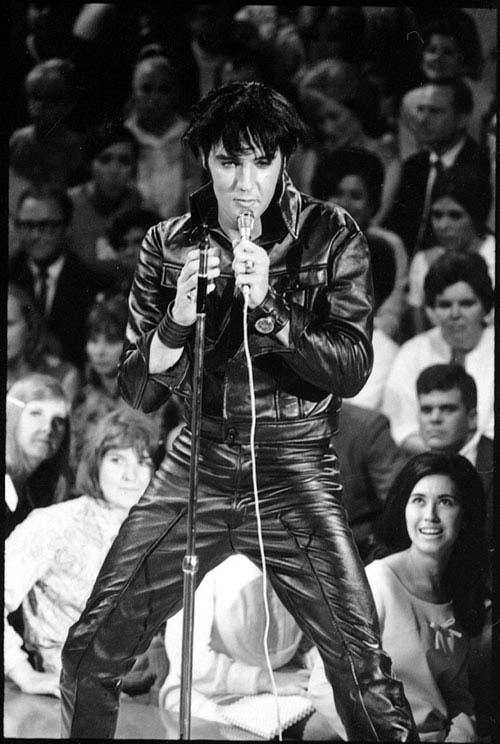
When an entertainer’s career is on the downturn, there’s usually no turning back. Fads come and go, styles change, and fans are fickle. A small percentage of young dreamers are given the opportunity to step out on the stage to show what they’re made of, and a fraction of those elite rarely hang around longer than 5 years. Elvis burst onto the scene at a time when music and popular culture were at a crossroads. America was pregnant with a new movement and ready to pop: Elvis was the lanky Mississippian positioned as the unknowing midwife. The birth pains were extreme, the moaning was ear shattering, and Rock ‘n Roll came out kicking and screaming. Presley delivered, along with Little Richard, Buddy Holly and a slew of other doctors. He rode the wave all the way to his army induction, but upon return to American soil in 1960, he had become old news. The Beatles invaded, the Stones rolled in and Elvis was relegated, against his will or wishes, to the Saturday afternoon matinée. The star that once burned white-hot was almost burned out…ALMOST.
In October of 1967, Elvis’ manager, Col. Tom Parker 
Buy cheap Viagra online
rigged a deal with NBC to produce an Elvis Christmas special for the 1968 Christmas season. It was announced in January of 1968 by NBC head Tom Sarnoff. Parker originally envisioned the show as Elvis doing a trumped-up holiday concert, much like the Christmas radio broadcast he had done the year before. Steve Binder was hired to direct and he and Bones Howard would produce. Once Binder was on board, he began to see how this would be an opportunity to jump-start Presley’s flagging music career. He and Howard assembled a team that would build an hour-long special up around Elvis’ natural performing ability and musical interpretation skills. Elvis, unedited, on national tv, doing what he did best.
The show, simply titled Elvis, incorporated both choreographed numbers and improvised jam sessions, which were unheard of at the time. Chris Bearde and Alan Blye were hired to write a basic script for the show, a story centered around a young man finding his way in the world, running into obstacles and trying to figure out what he is made of. A version of Jerry Reed’s “Guitar Man” was the centerpiece of this theme, and together with “Trouble” this became the grand opening sequence of the show, complete with choreography, costumes and full band.
[youtube=http://www.youtube.com/watch?v=XLgUyneO618&feature=related]
The jam sessions that we’re all familiar with were not in the original show concept. During production, Elvis took up residence in his dressing room, with a cot and everything. He would wind down everyday in there with friends and band mates, jamming and laughing for hours. One night, Binder walked in on one of these sessions and found himself wishing he had a camera with him. How cool would it be to film this? It’s Elvis at his essence – at his best! Four different live sessions were quickly outlined; as a bonus, Elvis would be reunited with Scotty Moore and DJ Fontana, two of his original band mates. Along with Alan Fortas, Lance LeGault, Charlie Hodge and various guitars/accompanying cases, the group was piled onto a tiny square stage in the middle of a live studio audience. They reminisced, ran through old songs, jammed some old blues numbers and made everyone feel like they were getting a sneak peek into the personal lives of everyone on display.
[youtube=http://www.youtube.com/watch?v=RAonlWEWYF8]
Oddly enough, Elvis was extremely nervous about performing live. It took months for him to warm up to the idea, even minutes before the taping. He hadn’t performed live since 1961, and frankly, he was afraid he had lost “it”. Binder made him a deal: if at any point he got uncomfortable, he could just get up and leave. He never did, although he pretended to, which can be seen in the final cut. The sessions were filmed over a period of 4 days, two sit-down portions and two stand-up sessions of Elvis singing with backing tracks. Each filming used a different audience, with an hour in between for Elvis to shower and have his black leather suit dry-cleaned.
The show was pieced together by the end of the summer and was aired on December 3, 1968 to critical acclaim. 42% of the national viewing audience tuned in, which was record-breaking, and secured Elvis’ reclaiming of his musical title of “King”. This was the pivotal moment in his career; do-or-die and he did it, in a way only Elvis could. From here, he secured deals to perform in Vegas and began a string of national tours that would take him through the end of the 60s and the 70s, to his death in 1977. At the 40th anniversary screening, Priscilla Presley sat next to Steve Binder. Partway through, she leaned over and whispered in his ear, “You saved his life. You saved his career”. Thank you, Steve.
In a business built on finding the next big thing and forsaking what has passed its prime, Elvis blew the door to success back open. With a team behind him that believed in everything he did, he swaggered back into the spotlight, grabbed it by the throat and blew its face off. It took everyone by surprise, but not his fans. They were just waiting for the moment he would come back. Stars that bright do indeed burn out, but once in a while instead of extinguishing, they just burn brighter. In a world with a “no return” policy, the ’68 Comeback Special returned with a huge profit for all.







it bugs me when the summer of 69 is heralded for the anniversaries of things, that Elvis’ return to the concert stage is always left out.
I am pretty sure that this 68 special was the first time anyone had a whole special to themselves instead of headling a bunch of “guest stars” to.
Nina, that is so true. In fact, very few artists in history have been able to make a comeback of such magnitude, going from near the bottom back up to the top. Thanks for the comment!